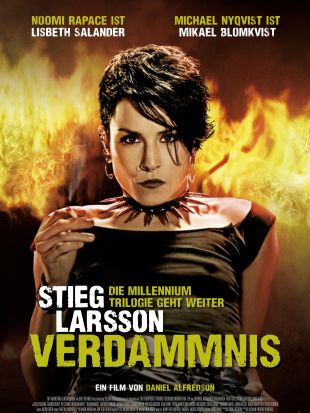
It has come to be accepted that the second entry in a blockbuster series of films based on a book or comic book will (usually) be superior to the first (see The Lord of the Rings: The Two Towers, Spider-Man 2 or X-Men 2 for evidence of this phenomenon). This quirk is most often attributed to the fact that while the first film is obligated to introduce and explain the characters and their backgrounds, the second film can dispense with the exposition in favor of fights, chase scenes, and explosions. Evidently, the producers of the Swedish film versions of Stieg Larsson's spectacularly popular "Millennium" novels were not aware of this cinematic convention, because they seem to have reversed the formulas for the first two films. Whereas The Girl with the Dragon Tattoo consistently and creatively indulged the audience's need for action and suspense, The Girl Who Played with Fire provides almost no kinetic drama, as virtually every scene is dominated by conversation and explanation. It's fortunate that the film's primary audience will be readers, because for much of the film there is little to do but read the subtitles to attempt to make sense of the proceedings.
What's worse is that, in spite of (or more likely, because of) all the dialogue, the sprawling investigation which forms the crux of the narrative is still bewildering and often completely incomprehensible, even to those who have read the books. Lisbeth Salander (Noomi Rapace) is accused of a triple murder, sparking a nationwide (wo)manhunt and a salacious media frenzy. One of the victims is a co-worker of journalist Mikael Blomkvist (Michael Nyqvist), whose life and career Salander saved in the first film, and he becomes determined to prove her innocence. This noble endeavor is hindered by the fact that Salander has mysteriously cut off all communication with Blomkvist making this perhaps the first thriller in history where the two principal protagonists are separate throughout virtually the entire film. Blomkvist believes that the key to the murders must be hidden in a story about sex trafficking that his dead colleague had been working on, but of course the police haven't the slightest interest in entertaining his theories as they doggedly and ineptly track Salander. While the cops flounder about uselessly, Salander begins her own unique (and much more effective) inquiry, using her photographic memory, computer expertise, and impeccable instincts to easily obtain whatever tidbit of information she requires to propel her to the next step of her investigation. In fact, her skills of deduction are so adept that they are at least once taken completely for granted, as she tracks a key piece of evidence to a cabin in the woods without any explanation of how she determined the cabin's whereabouts. She is also blessed with precision timing, as a pair of thugs show up to burn the cabin at the exact moment she is leaving. Later, she stakes out a post-office box for about an hour before the owner thoughtfully appears to lead her to her next appointed destination.

While Salander's version of the investigation proceeds remarkably smoothly, Blomkvist, the police, and the audience are continually baffled as peripheral characters keep popping up with pertinent clues. Perhaps the most amusing instance of this occurs when Swedish boxer and TV star Paolo Roberto makes an inexplicable cameo appearance which is then suddenly extended into a decisive role. While the supposed hero Blomkvist is boring us to tears with interviews and computer searches, Roberto is the center of the film's only action set piece, as he does battle with a gargantuan bad guy before rescuing a woman from a burning barn. Then, as if to prove that he has the brains to match his brawn, Roberto announces that (thanks to a five-minute phone call) he's uncovered the identity of the film's villain, a mystery that has occupied Blomkvist for the better part of the film's run time.
It's worth stating that all of these narrative flaws (and many more, including an absurd climax where Salander does her best impression of Jason Voorhees) are pulled straight from Larsson's novel, and therefore anyone interested in diving into this chapter of the adventures of Lisbeth Salander would do well to put the cost of their movie ticket towards a copy of the book, which at least has the luxury of 600 pages with which to justify and disguise its imperfections.
